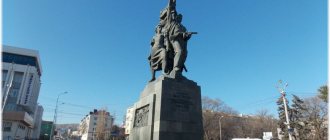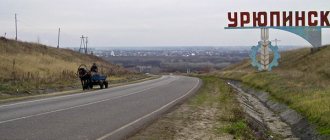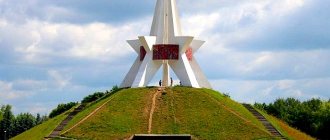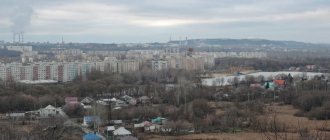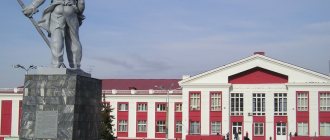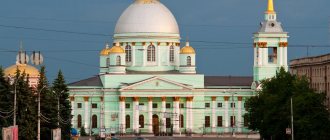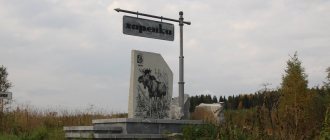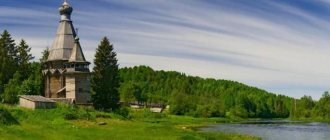> Countries Russia
Volgograd is a truly unique city, where each historical era radically changed its appearance. Each period had its own name: pre-revolutionary Tsaritsyn, Soviet Stalingrad and post-war modern Volgograd.
Tsaritsyn had many churches, wooden buildings, red brick houses and narrow streets. After the Battle of Stalingrad the center was practically destroyed. In the post-war years, a different layout was created with new streets and buildings. At the same time, Volgograd became a real industrial center with many enterprises.
The city continues to change now: new public spaces, a sports stadium and modern buildings are appearing. The center here is quite large, so it is important to know what to pay attention to first, where to find interesting points that only locals know about, and what history is behind Volgograd buildings and monuments.
- List of attractions
- Unusual places
- Neighborhood
Climate
The Volgograd region is located 1000 km southeast of Moscow. The Black and Azov Seas are nearby, and they have a huge impact on the local climate. The region is characterized by little snow and short winters. Due to the flat terrain, cold air from the continent easily penetrates into the Volgograd region, and the temperature drops to -10...-11°C.
Museum-reserve "Battle of Stalingrad" in Volgograd
Spring starts early. In March it is already warm, and primroses are blooming with might and main. Summer can be hot. In terms of abundance of sunshine, the region is in no way inferior to the famous resorts of Crimea
. When the winds bring hot air from the Kazakh steppes, the thermometer rises +39...+45°С.
Autumn is warm and lasts a long time. The first snow falls only in early December. There is not much rainfall during the year. In the Volga region it is only 270-300 mm, and in the north-west of the region - up to 400-500 mm.
Alexandrovsky graben
The Alexandrovsky graben is one of the unique geological places in the Volgograd region. A graben is a section of the earth's crust that has descended along tectonic faults in relation to its neighbors. Most often they are found in mountainous countries, so the size of the Alexander Graben is relatively small - only a few kilometers by a few meters in width, but the “depth” of its failure is about 200 m, and at its bottom there is a small beautiful lake.
The study of the Alexander Graben allows scientists to decipher the history of geographical events of these places - formations and relics of the Ice Age, silty lake sediments during the hot climate of the Neogene, evidence of the existence of a coastal marine zone here.
Museums
Church in the museum "Old Sarepta"
There are many museums in the Volgograd region, and the most interesting collections are kept in the regional center. Volgograd residents joke that the museum business in the city began with a cap and a cane, which were granted to local residents by Russian Tsar Peter I. It is noteworthy that unusual royal gifts are still kept in the city hall.
Where should you go first? Those interested in history should visit the local history museum. It has existed for more than a hundred years and is located in a three-story building of the former zemstvo government, on Lenin Street, 7.
Mamaev kurgan. View of the monument “The Motherland Calls!” and the sculpture “Stand to the death”
In the second half of the 18th century, by decree of Empress Catherine II, the first colony of foreign settlers was founded, who came to Russia from various European countries, mainly from Germany
. The unusual museum “Old Sarepta” is dedicated to its history and cultural heritage, which is located on Izobilnaya Street, 10. The museum has a library where rare books in German are stored.
Mamaev Kurgan , famous far beyond the borders of Volgograd.
.
Today it is a place of mourning for those killed during the Great Patriotic War. The memorial complex of giant sculptures is dedicated to the heroes of the Battle of Stalingrad. In 2008, Mamayev Kurgan was recognized as one of the Seven Wonders of Russia
.
Volgograd Memorial and Historical Museum
A lot of tourists come to the Memorial Historical Museum, dedicated to the distant events of the Civil War. It is located in a red-brick merchant mansion at 10 Gogol Street.
To look at the famous panorama of the Battle of Stalingrad, you need to go to Marshal Chuikov Street, 47. In addition to a huge painting, the military museum displays samples of weapons and equipment from the Second World War, personal belongings of soldiers and officers, letters from the front and battle flags.
View of the building of the Panorama Museum "Battle of Stalingrad"
Since the 1960s, the Museum of Fine Arts has been opened at Lenin Avenue, 21. Its halls display works by Volgograd artists and sculptors, works by painters from Europe and a collection of works by the artist Ilya Ivanovich Mashkov, whose name the museum bears. In recent years, new collections have opened in the regional center - the Museum of Weights and Measures (Aviator Highway, 11A) and the Museum of Photographic Cinematics and Photographic Art (Kuznetskaya Street, 73A).
There are historical and local history museums in the cities of Nikolaevsk, Volzhsky, Kalach-on-Don, Mikhailovka, Frolovo, Dubovka, Kamyshin, Leninsk Uryupinsk, Pallasovka, in the village of Alekseevskaya, in the villages of Danilovka and Elan. Museums dedicated to the Don Cossacks are open in the village of Ilovlya, the village of Kletskaya and the city of Serafimovich.
View of the entrance to the Volgograd Museum of Fine Arts. I.I. Mashkova
Job
There are quite a lot of vacancies in Gorodishche, so you can find work in different fields of activity. Here we need a florist, an accountant, drivers, sellers and employees for working specialties - tractor drivers, field workers, gardeners and many others.
For example, an organization specializing in the wholesale sale of chicken eggs and meat products requires an accountant. Salary – 25 thousand rubles + bonus, personal car and experience in sales are required. The employee's responsibilities include searching for clients and further working with them. (Advertisement on Avito No. 2156405458).
I want to meet a girl) Phone number and photos in Volgograd on a private dating site.
Fishing
The Volgograd region is one of the regions of our country where you can enjoy high-quality fishing and are guaranteed to get a big catch.
Fishermen with spinning rods, donks and fillers can be found on almost all rivers and reservoirs.
The areas around Krasnoslobodsk, the villages of Pokrovka, Leshchev, Barbashi and Gromki are considered catching places on the Volga. Carp, pike, chub, perch and asp bite well here. They actively fish on the upper reach of the Tsimlyansk Reservoir, near Sarpinsky Island, on sand spits and river holes below the regional center and along the banks of the spacious Volgograd Reservoir.
Volzhskaya HPP
On Akhtuba, the villages of Tsarev and Solodovka are known among fishermen, and on Khopra, the outskirts of the village of Tishanka and the Buzuluk river. There are many crayfish in local reservoirs. True, their catching is allowed only in the fall.
On the Don River, within the borders of the region, they catch catfish, carp, bream, silver crucian carp, pike perch and silver bream, which locals call “zobany” and “kalinka”. The bite is especially active in the first half of summer.
Population of Gorodishche
Since the first census data dated 1842, the population was then 1,251 people. Until 1883, it increased and amounted to 1,956 residents; over the next 5 years it decreased by 200 people, but then there was a sharp jump, and by 1891 there were already 2,158 local residents. By 1911, the number of residents was more than 3,000 people.
In the post-war years, the population grew constantly. In 1959, 6,715 residents lived here, in 1989 - more than 15,000 people, and in the early 2000s this number approached 20,000. To this day, there has been a steady increase in the number of residents, and currently 23,686 people live in Gorodishche.
Natural parks and reserves
Lake Elton
There are about 40 unique natural areas in the region that have a special protection status.
About fifty more natural sites are waiting to be included in this list.
What places attract tourists the most? Many travelers come to the north of the region to see the unique hilly landscape of the Shcherbakovsky natural park.
Here, mountain oak forests are combined with rocky cliffs, and karst fields with virgin steppes overgrown with grass.
Of particular value are the Urakov Hill, the rocky formations of Shcherbakovskaya Balka and Stolbichi.
Stolbichi on the banks of the Volga
In the thickets of bushes and forests you can find herds of wild boars and roe deer, elk and European deer. Birds of prey—the Imperial Eagle, the White-tailed Eagle, and the Greater Spotted Eagle—soar above the open spaces where marmots live. Tourists coming to Shcherbakovsky stay in tents and cook food over a fire.
The natural park in the Volga-Akhtuba floodplain attracts lovers of small lakes, eriks, floodplain meadows and oak forests like a magnet. From Volgograd, the road to the park takes only an hour, so on weekends residents of the regional center and the neighboring city of Volzhsky go out into nature.
View of the chalk mountains in the Donskoy natural park
People come to Akhtuba to see the blooming lake of pink lotuses and watch the birds living near the water - the yellow heron, white stork, laughing gulls and waders. Unlike other protected areas, about 33 thousand people permanently live and farm in this park.
The Donskoy Natural Park is known for the largest chalk mountains in Europe, the purest springs with icy water and an ethnographic museum dedicated to the history and life of the Cossacks.
People go to Eltonsky to see the salt lake Elton, the unique Ulagan salt mountain and the abandoned village of salt miners. In April, bright tulips bloom in large quantities in the steppe.
The “Union of Fronts” monument in Pyatimorsk, dedicated to the meeting of the troops of the South-Western and Stalingrad fronts
Fans of archeology are long-time regulars of the Ust-Medveditsky park, which is spread over an area of more than 50 thousand hectares. Along the banks of the rivers flowing here, many burial mounds and sites of Bronze Age nomads have been discovered.
Animal lovers love the Tsimlyansky Sands park, where herds of wild horses - mustangs - graze freely.
The territory of the Nizhnepekhorsky park is often called an open-air museum. It contains floodplain forests with trees more than four hundred years old. In the beautiful Shakinsky oak grove you can see the amazing spring “Bubbling Well”.
Ust-Medveditsky Spaso-Preobrazhensky Monastery near the city of Serafimovich
When planning a trip to any of the protected areas of the Volgograd region, you should keep in mind that hunting and fishing are prohibited there. You can set up tents and make fires only in specially designated areas.
Modern objects in Volgograd, interesting to visit
Volgograd has a large number of modern objects and interesting places that are not related to the historical heritage of the city, but will also be interesting for tourists to visit.
Tkachevsky market
The largest market in the city, located on the street. Tkacheva, 14A. Open daily until 16-00. Here you can find any goods and items of public consumption. Prices on the market are on average 10-15% lower than in city supermarkets. This place is worth visiting not only to shop, but also to plunge into the special atmosphere of trade, which is typical only for the south-eastern regions of Russia.
Sweet Life
One of the most popular nightclubs in the city. Opens at 18-00 and works throughout the night until the last customer. Located at: Embankment 62-1 Armii, 6.
Here you can have fun with friends, drink cold beer, the average cost of which is 200 rubles. for 1 liter, try delicious cocktails and dance. Admission is free for both boys and girls.
Garden Bar
Entertainment establishment, which is located at: st. Lenina, 56A. This institution operates 24 hours a day. Here you can have a pleasant time, drink a cup of coffee, which costs 120 rubles, or enjoy a cocktail for 250 rubles. or have a delicious meal for 700-800 rubles.
Inside the establishment there is a cozy atmosphere with soft sofas and armchairs, a fireplace is burning, which creates a special atmosphere in the room. The staff is very attentive and responsive.
Souvenirs
What do tourists take away as souvenirs on a trip to the Volgograd region? Many travelers buy miniature copies of the famous monument on Mamayev Kurgan and things with military symbols.
They are sold in souvenir shops on the territory of the memorial and in city kiosks.
War Memorial Cemetery in Rossoshki
Women willingly take light and warm down scarves from skilled Uryupinsk craftswomen.
Practical and high-quality products keep you warm in the cold and look very beautiful.
The Volga city has the unofficial status of the Russian capital of mustard oil, and tourists are happy to buy bottles of oil from Sarepta mustard seeds. They are sold in any grocery store in Volgograd.
Cathedral of the Kazan Icon of the Mother of God in Volgograd
Those with a sweet tooth are sure to bring home chocolates, caramels and marshmallows from the Confip factory. Boxes with photographs of Volgograd sights are especially popular. As delicious souvenirs, tourists take home sweet and juicy Volgograd watermelons, delicate watermelon honey, as well as dried and smoked fish.
| ← RUSSIA | EUROPE → |
Schools
In the working-class village of Gorodishche there are three comprehensive secondary schools. Another 17 schools operate in the district.
School No.1 in the village. Gorodishche was founded in 1897. At that time there was only 1 teacher for every 95 students. Since 1914, the school was renamed an elementary school, and since 1917 it became a secondary school. The educational institution moved to a new building in 1967. And in 1985, an extension with a gym and a dining room was built. The school hours are from 7 a.m. to 7 p.m., 6 days a week.
School No.2 was created in February 1992. It operates on a five-day basis. Lessons start at 8:00 am. School No. 3 was founded in 1989. It works in one shift from 7.40 to 18 o'clock, on Saturdays - from 8.00 to 15 o'clock, closed on Sundays.
How to get around Volgograd
You can move around the city using the following types of public transport, which start running from 06:00 a.m. to 11:00 p.m.:
- trolleybus (cost 15 rubles);
- high-speed tram, 6 stations of which are underground (ticket price 12 rubles);
- buses (fare costs 25 rubles).
Visiting interesting places in Volgograd can be organized using a taxi, the average cost of which is from 300 to 700 rubles. depending on the distance of the trip.
Volgograd is a city with a rich and dramatic history, having studied which it is impossible to remain indifferent. Most people who have visited here as tourists fondly remember the city, the responsiveness of its inhabitants and the beauty of the Volga region.
Article design: Mila Friedan
Interesting places to relax with children
When traveling around Volgograd with children, you can have a pleasant time with the whole family by visiting the following interesting places in the city.
Mobius strip maze
This is an entertainment complex that includes a labyrinth assembled from a large number of ribbons. They create the illusion of infinity and make it difficult to navigate the winding tunnels of the labyrinth.
Located near Mamayev Kurgan on the street. Zemlyachki, 110B. Recommended for visiting by children aged 5 to 12 years. The ticket price is 150 rubles.
Oceanarium
The Volgograd Oceanarium is a place of simultaneous discovery and entertainment. It will be interesting here for both children and their parents. Visitors to the aquarium have the opportunity to see crocodiles, penguins, sea turtles and other inhabitants of the deep waters. The entertainment center is located on the street. Zemlyachki, 110, B. The cost of the entrance ticket is 200 rubles.
Trampoline center Gravity
This is a complex of large and durable trampolines that allow children and parents to forget about gravity and soar in the air with minimal physical exertion. Located at: st. Kozlovskaya, 42. You will have to pay 300 rubles for visiting the Trampoline Center. per person.
Where to eat in Volgograd
There are many cozy cafes and restaurants in Volgograd, where the food is tasty, satisfying and at a low cost.
The following establishments are recommended for visiting:
- Voronka coffee shop – located on the street. Komsomolskaya, 10, there is exclusively European cuisine, suitable for vegetarians, the average bill is 300 rubles;
- the restaurant Shchastye Is - an establishment of French cuisine with an average cost of dishes from 250 to 800 rubles, located at the address: Alleya Heroev, 2;
- Restaurant Gifts of Armenia is an establishment of Caucasian cuisine, which is located on the street. Parkhomenko, 15a, the average cost of lunch here is 500-600 rubles;
- Chocolaterie Brownie Store - a pastry cafe that sells sweets made with chocolate and also brews delicious coffee, average prices are 700-900 rubles, located on the street. Chuikova, 21;
- cafe Marusya – located at the address: Alley of Heroes, 2, here visitors can try European and Russian cuisine, many fish dishes, the average bill is 700-1000 rubles.
Most city guests who dined in Volgograd restaurants and cafes noted that the most delicious dishes are those made from fish. The leader of consumer preferences is fish soup, as well as sterlet with cheese.
Hotels in Volgograd
While in Volgograd on a business trip or traveling around the city as a tourist, you can stay in the following hotels:
- Volgograd Hilton - price for accommodation here is 3,600 rubles. per day, the price includes breakfast, free internet, parking (located on Profsoyuznaya str., 13);
- Stalingrad - the hotel is located on the street. Rokosovsky, 102, cost of living here is 2450 rubles. per day, you can order breakfast, for which you will have to pay 380 rubles, there is free internet;
- Mini-hotel Sonberry is a budget option that will cost 1,500 rubles. per day, located on the street. Dymchenko, 8, rooms are equipped with all amenities, meals are not included in the price;
- The Sosnovy Bor estate is a cottage complex, accommodation in which costs 7,000 rubles. per day, the hotel is located on the street. Angarskaya, 137/181;
- Plaza – a hotel with comfortable rooms, which is located on the street. Novouzenskaya, 2/1, the price of living here is 1,700 rubles. per person.
While in Volgograd, you can choose a hotel for any budget, from economy class to expensive apartments or an individual cottage, such as the Sosnovy Bor Estate.

